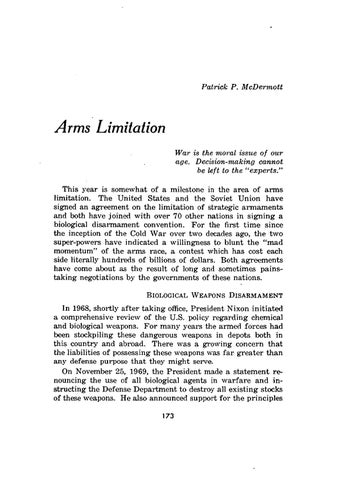Patriek P. McDermott
Arms Limitation Wm¡ is the moml issue of our age. Deciswn-making cannot be left to the "experts." This year is somewhat of a milestone in the area of arms limitation. The United States and the Soviet Union have signed an agreement on the limitation of strategic armaments and both have joined with over 70 other nations in signing a biological disarmament convention. For the first time since the inception of the Cold War over two decades ago, the two super-powers have indicated a willingness to blunt the "mad momentum" of the arms race, a contest which has cost each side literally hundreds of billions of dollars. Both agreements have come about as the result of long and sometimes painstaking negotiations by the governments of these nations. BIOLOGICAL WEAPONS DISARMAMENT
In 1968, shortly after taking office, President Nixon initiated a comprehensive review of the U.S. policy regarding chemical and biological weapons. For many years the armed forces had been stockpiling these dangerous weapons in depots both in this country and abroad. There was a growing concern that the liabilities of possessing these weapons was far greater than any defense purpose that they might serve. On November 25, 1969, the President made a statement renouncing the use of all biological agents in warfare and instructing the Defense Department to destroy all existing stocks of these weapons. He also announced support for the principles 173
